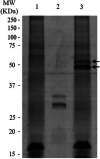Dirofilaria immitis possesses molecules with anticoagulant properties in its excretory/secretory antigens
- PMID: 31992384
- PMCID: PMC10317642
- DOI: 10.1017/S0031182020000104
Dirofilaria immitis possesses molecules with anticoagulant properties in its excretory/secretory antigens
Abstract
Dirofilaria immitis is a parasitic nematode that survives in the circulatory system of suitable hosts for many years, causing the most severe thromboembolisms when simultaneous death of adult worms occurs. The two main mechanisms responsible for thrombus formation in mammals are the activation and aggregation of platelets and the generation of fibrin through the coagulation cascade. The aim of this work was to study the anticoagulant potential of excretory/secretory antigens from D. immitis adult worms (DiES) on the coagulation cascade of the host. Anticoagulant and inhibition assays respectively showed that DiES partially alter the coagulation cascade of the host and reduce the activity of the coagulation factor Xa, a key enzyme in the coagulation process. In addition, a D. immitis protein was identified by its similarity to the homologous serpin 6 from Brugia malayi as a possible candidate to form an inhibitory complex with FXa by sodium dodecyl sulfate polyacrylamide gel electrophoresis and mass spectrometry. These results indicate that D. immitis could use the anticoagulant properties of its excretory/secretory antigens to control the formation of blood clots in its immediate intravascular habitat as a survival mechanism.
Keywords: Anticoagulant; Dirofilaria immitis; coagulation cascade; excretory/secretory antigens; factor Xa; serpin.
Figures




Similar articles
-
Excretory/secretory antigens from Dirofilaria immitis adult worms interact with the host fibrinolytic system involving the vascular endothelium.Mol Biochem Parasitol. 2012 Feb;181(2):134-40. doi: 10.1016/j.molbiopara.2011.10.010. Epub 2011 Oct 25. Mol Biochem Parasitol. 2012. PMID: 22050927
-
Involvement of the excretory/secretory and surface-associated antigens of Dirofilaria immitis adult worms in the angiogenic response in an in-vitro endothelial cell model.Vet Parasitol. 2023 Jun;318:109939. doi: 10.1016/j.vetpar.2023.109939. Epub 2023 Apr 27. Vet Parasitol. 2023. PMID: 37121093
-
Parasite excretory-secretory antigen and antibody to excretory-secretory antigen in body fluids and kidney tissue of Dirofilaria immitis infected dogs.Am J Trop Med Hyg. 1988 Oct;39(4):380-7. doi: 10.4269/ajtmh.1988.39.380. Am J Trop Med Hyg. 1988. PMID: 3189699
-
What is new in the Wolbachia/Dirofilaria interaction?Vet Parasitol. 2005 Oct 24;133(2-3):127-32. doi: 10.1016/j.vetpar.2005.02.005. Epub 2005 Apr 11. Vet Parasitol. 2005. PMID: 16198819 Review.
-
The prevalence of Dirofilaria immitis and D. repens in the Old World.Vet Parasitol. 2020 Apr;280:108995. doi: 10.1016/j.vetpar.2019.108995. Epub 2019 Nov 21. Vet Parasitol. 2020. PMID: 32155518 Review.
Cited by
-
Proteomic differences between extracellular vesicles and extracellular vesicle-depleted excretory/secretory products of barber's pole worm.Parasit Vectors. 2024 Jan 12;17(1):17. doi: 10.1186/s13071-023-06092-6. Parasit Vectors. 2024. PMID: 38217036 Free PMC article.
-
The Angiostrongylus vasorum Excretory/Secretory and Surface Proteome Contains Putative Modulators of the Host Coagulation.Front Cell Infect Microbiol. 2021 Nov 2;11:753320. doi: 10.3389/fcimb.2021.753320. eCollection 2021. Front Cell Infect Microbiol. 2021. PMID: 34796127 Free PMC article.
-
Hidden in plain sight: How helminths manage to thrive in host blood.Front Parasitol. 2023 Mar 10;2:1128299. doi: 10.3389/fpara.2023.1128299. eCollection 2023. Front Parasitol. 2023. PMID: 39816845 Free PMC article. Review.
-
Comparison of viscoelastic coagulation parameters, blood loss and surgical time between asymptomatic heartworm antigen-positive and negative dogs presented for elective gonadectomy.J Small Anim Pract. 2025 May;66(5):314-320. doi: 10.1111/jsap.13834. Epub 2025 Feb 13. J Small Anim Pract. 2025. PMID: 39945119 Free PMC article.
-
Case report: Disseminated intravascular coagulation in a dog following treatment with melarsomine for Dirofilaria immitis.Front Vet Sci. 2023 Feb 6;10:1118798. doi: 10.3389/fvets.2023.1118798. eCollection 2023. Front Vet Sci. 2023. PMID: 36814463 Free PMC article.
References
-
- Adams RL and Bird RJ (2009) Review article: coagulation cascade and therapeutics update: relevance to nephrology. Part 1: overview of coagulation, thrombophilias and history of anticoagulants. Nephrology (Carlton) 14, 462–470. - PubMed
-
- Arneth B (2019) Coevolution of the coagulation and immune systems. Inflammation Research 68, 117–123. - PubMed
-
- Bendtsen JD, Nielsen H, von Heijne G and Brunak S (2004) Improved prediction of signal peptides: SignalP 3.0. Journal of Molecular Biology 340, 783–795. - PubMed
Publication types
MeSH terms
Substances
LinkOut - more resources
Full Text Sources
Medical

